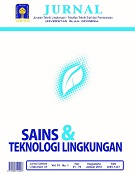Main Article Content
Abstract
Gas stations are a common source of groundwater contamination by petroleum hydrocarbons. These pollutants are a health concern when people come in contact with the contaminated water when pumping from polluted wells, for example. However, in Indonesia this problem remains largely ignored, despite some prominent leakage incidents at gas stations. The purpose of this study is to investigate the groundwater contamination by petroleum hydrocarbon from gas station in the greater Yogyakarta area in Indonesia. Screening criteria such as construction standards, reported leakage incidents, and geological and hydrogeological condition were used to identify gas stations with high risk of water contamination by petroleum hydrocarbon. Gas station with close proximity with dug wells in which its water had been used for human daily consumption was selected for further analysis. Groundwater samples were then collected from dug wells located in the vicinity to this selected gas station and then analyzed for benzene, toluene, ethylbenzene, xylene (BTEX) by gas chromatography/mass spectrometry. Of the six sampling points, BTEX were detected with concentrations ranging from 0,008 to 25,631 ppb. Concentration of benzene at sampling point 3 exceed the standards of Indonesian drinking water quality and WHO. These findings indicate that BTEX groundwater pollution may be a health hazard of currently unknown proportion in the greater Yogyakarta area. It is recommended to assess health risk associated with human daily consumption of BTEX polluted groundwater and also to test groundwater at all gas stations in this area and remediate those affected by BTEX.
Keywords
Article Details
Authors who publish with this journal agree to the following terms:
- Authors retain copyright and grant the journal right of first publication with the work simultaneously licensed under a Creative Commons Attribution License that allows others to share the work with an acknowledgement of the work's authorship and initial publication in this journal.
- Authors are able to enter into separate, additional contractual arrangements for the non-exclusive distribution of the journal's published version of the work (e.g., post it to an institutional repository or publish it in a book), with an acknowledgement of its initial publication in this journal.
- Authors are permitted and encouraged to post their work online (e.g., in institutional repositories or on their website) prior to and during the submission process, as it can lead to productive exchanges, as well as earlier and greater citation of published work (See The Effect of Open Access).
References
- Deghani, M., Fazlzadeh, M., Sorooshian, A., Tabatabaee, H., Miri, M., Baghani, A., Delikhoon, M., Mahvi, A., Rashidi, M., 2018. Characteristics and health effects of BTEX in a hot spot for urban pollution. Ecotoxicology and Environmental Safety. 155 (2018) 133-143
- Muryani, Eni. 2012. Zonasi Potensi Pencemaran Bahan Bakar Minyak terhadap Air Tanah Bebas (Studi Kasus SPBU 44.552.10 Yogyakarta). Jurnal Sains dan Teknologi Lingkungan ISSN:2085-1227, 2012. - Vol. 4
- Pertamina. 2016. Embracing Change, Leveraging Challenges. Annual Report. Available at : https://www.pertamina.com/Media/12350c89-ae5d-4e2b-b747-930d5c78ac2e/AR-2016-PERTAMINA.pdf
- Pijuan, M.Roldan, M.C Alcudia-Leon, R. Lucena, S. Cardenas, M. Valcarel. 2012. Stir Frit Microextraction: An Approach for the Determination of Volatile Compounds in Water by Headspace-Gas Chromatography/Mass Spectrometry. Journal Chromatography A- Vol 1251 (2012) 10-15
- Rosales, R., Martinez-Pagan, P., Faz, A., Bech, J. 2014. Study of subsoil in former petrol stations in SE of Spain: Physicochemical characterization and hydrocarbon contamination assessment. Journal of Geochemical Exploration. 147 (2014) 306-320
- Serrano, A and M. Gallego. 2004. Direct Screening and Confirmation of Benzene, Toluene, Ethylbenzene and Xylenes in Water. Journal of Chromatography A-Vol. 1045 (2004) 181-188.
- Standar Nasional Indonesia (SNI) 6989.58:2008. Air dan Air Limbah Bagian 58 : Metoda Pengambilan Contoh Air Tanah. Jakarta : Badan Standarisasi Nasional Indonesia
- Turner, N. R., and D. Abigail Renegar. 2017. Petroleum hydrocarbon toxicity to corals: A review. Marine Pollution Bulletin. Volume 11, Issue 2, 30 June 2017, pages 1-16.
- Weiner, Eugene. R. 2012. Applications of Environmental Aquatic Chemistry : A Partical Guide, Third Edition. CRC Press, Taylor and Francis Group
- WHO . 2008. Guidelines for Drinking Water Quality. Third Edition Incorporating the First and Second Addenda. World Health Organization, Geneva, Switzerland
References
Deghani, M., Fazlzadeh, M., Sorooshian, A., Tabatabaee, H., Miri, M., Baghani, A., Delikhoon, M., Mahvi, A., Rashidi, M., 2018. Characteristics and health effects of BTEX in a hot spot for urban pollution. Ecotoxicology and Environmental Safety. 155 (2018) 133-143
Muryani, Eni. 2012. Zonasi Potensi Pencemaran Bahan Bakar Minyak terhadap Air Tanah Bebas (Studi Kasus SPBU 44.552.10 Yogyakarta). Jurnal Sains dan Teknologi Lingkungan ISSN:2085-1227, 2012. - Vol. 4
Pertamina. 2016. Embracing Change, Leveraging Challenges. Annual Report. Available at : https://www.pertamina.com/Media/12350c89-ae5d-4e2b-b747-930d5c78ac2e/AR-2016-PERTAMINA.pdf
Pijuan, M.Roldan, M.C Alcudia-Leon, R. Lucena, S. Cardenas, M. Valcarel. 2012. Stir Frit Microextraction: An Approach for the Determination of Volatile Compounds in Water by Headspace-Gas Chromatography/Mass Spectrometry. Journal Chromatography A- Vol 1251 (2012) 10-15
Rosales, R., Martinez-Pagan, P., Faz, A., Bech, J. 2014. Study of subsoil in former petrol stations in SE of Spain: Physicochemical characterization and hydrocarbon contamination assessment. Journal of Geochemical Exploration. 147 (2014) 306-320
Serrano, A and M. Gallego. 2004. Direct Screening and Confirmation of Benzene, Toluene, Ethylbenzene and Xylenes in Water. Journal of Chromatography A-Vol. 1045 (2004) 181-188.
Standar Nasional Indonesia (SNI) 6989.58:2008. Air dan Air Limbah Bagian 58 : Metoda Pengambilan Contoh Air Tanah. Jakarta : Badan Standarisasi Nasional Indonesia
Turner, N. R., and D. Abigail Renegar. 2017. Petroleum hydrocarbon toxicity to corals: A review. Marine Pollution Bulletin. Volume 11, Issue 2, 30 June 2017, pages 1-16.
Weiner, Eugene. R. 2012. Applications of Environmental Aquatic Chemistry : A Partical Guide, Third Edition. CRC Press, Taylor and Francis Group
WHO . 2008. Guidelines for Drinking Water Quality. Third Edition Incorporating the First and Second Addenda. World Health Organization, Geneva, Switzerland
